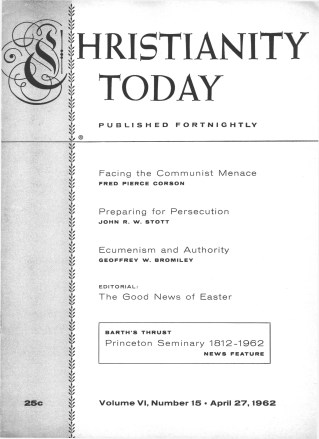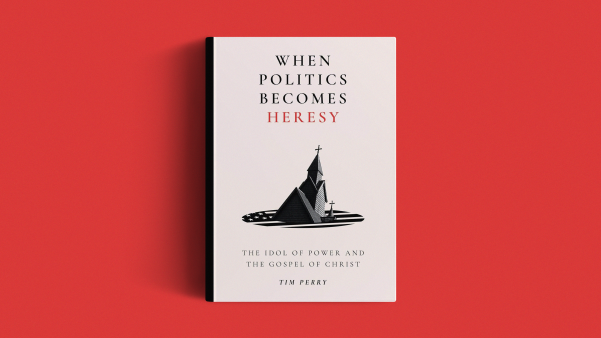Christianity today’s series of articles on Bultmann raises the question: Why has the neoorthodox theology (of Karl Barth) not been able to avoid a relapse to liberalism (Rudolf Bultmann)? This is a most interesting and revealing question, even if Continental theology might state the question in somewhat different terminology.
From Theology To The Bible
What happened? Since 1945 the focus of theological discussion shifted not only from Barth to Bultmann, but also from systematic theology to biblical exegesis. Between 1920 and 1940 systematic theology mainly furnished the topics of discussion, such as the question of natural theology. The theological student chose his university primarily on the basis of the kind of systematic theology represented there: thus he went to Bonn to study dialectic theology under Barth, or to Erlangen to be taught neo-Lutheran theology by Paul Althaus and Werner Elert, or to Tübingen for Karl Heim, or to Zürich for Emil Brunner. Whereas before World War I there was the danger of theology’s being dissolved into philosophy and history of religion, these men had restored it as an important factor in the field of thought. Consequently the number of theological students rose impressively. Largely through these men the Church was enabled to assume a clear-cut position over against her adversaries, particularly against the oppressive measures of national socialism.
Following the German catastrophe of 1945 this theology had its great share in reorganizing the Church; the neo-Lutheran theology of W. Elert shaped—at least partially—the United Evangelical Lutheran Church of Germany, and similarly the theology of Karl Barth left its imprint on the Evangelical Church of the Union. But the first theological topic which was commonly discussed after 1945 was put by exegesis: it was Bultmann’s program of demythologization! Bultmann himself had developed this program (without its eventual title) already in his essays and writings during the twenties; but while at that time it attracted limited attention, it now became widely debated, not only by theologians, but also by the general public. During the fifties the “Bultmann School” came to be one of the most influential factors in theological discussion; it is now represented in most of the West German theological faculties, and it has its own platform in the Zeitschrift für Theologie und Kirche.
In order to give a proper explanation to the prominence given to Bultmann and his school one must note also a parallel theological interest in Old Testament exegesis, centered particularly in the school around G. von Rad and M. Noth. The faculty in which G. von Rad was teaching attracted more students during the fifties than any other theological faculty in Germany. G. von Rad’s “Old Testament Theology” (Theologie des Alten Testaments) is rightly regarded as the most outstanding work of German theology since 1945. Each year there are more copies sold of the Neukirchener-Biblischen Kommentar zum Alten Testament, edited by this school, as well as of the new volumes of the Meyer Commentary, than were sold of any comparable work in ten years before the war! And only a very small percentage of these commentaries originates from the Bultmann school.
‘Reinterpreting’ Scripture
This overall picture of the situation provides a preliminary answer to the question: how could Bultmann’s influence outgrow Barth’s? Systematic theology in general was pushed into the background by biblical exegesis! And we must go on asking: how could that happen?
This process appears to me a good indication that the sola scriptura principle of the Reformation is still valid? The second decisive reason, however, was critical exegesis. We are gradually learning that the rise of historical research in Scripture during the eighteenth century has been, not a second Reformation, as is frequently said, but rather the most important theological event since the Reformation period. The terms of reference look very convincing at first glance: the body of literature incorporated in the Bible is to be scrutinized and exposed in exactly the same way as were other documents of the same time, namely, according to the principles of analogy, correlation, and criticism, to employ E. Troeltsch’s terms. But what does that mean? It means that the hermeneutical rule of the Reformation was abandoned, according to which Scripture was to be explained through Scripture, and Scripture again through faith in Christ! Thus Scripture is made the victim of the methods of modern autonomous science and of its underlying philosophical presuppositions! From the viewpoint of the history of thought, this was inevitable; for autonomous science had conquered step by step all areas of life since the day of the Renaissance. From the viewpoint of theology, however, this was at least partly necessary; for the biblical writings are real historical documents and the Son of God was born not only man, but a Jewish man of the first century. This is why historical Scripture research is necessary! But what was the result of this work? Historical Scripture research opened up to exegesis an invaluable treasure vault of philological and history-of-religion insights, but before World War I it ended in the so-called history-of-religion school (Religionsgeschichtliche Schule), by dissolving biblical exegesis into mere Religionsgeschichte. Original Christianity appeared as a branch of the Jewish or Hellenistic history of religion. Why it was still distinct from both could no longer be explained. Thus purely historical research had ultimately failed not only theologically, but also historically. This is why after World War I a change of attitude took place within historical research itself. Previously only those exegetes like J. Chr. K. Hofmann, J. T. Beck, and A. Schlatter, who stood somewhat removed from it, had pointed out that historical work with the Bible had to take the thinking of faith as its starting point, and not some philosophical ideology. Now, however, corresponding insights were perpetuated even within the circles engaged in historical research.
This happened through Barth and Bultmann. Both men had studied exegesis, not under A. Schlatter or Th. Zahn, but in the history-of-religion school, yet both of them discovered the limits of the “purely historical” exegesis. As a young Swiss pastor wrestling with the exegesis of Romans, Barth gained an insight which he expressed in the preface to his Commentary on Romans (1922): “The Epistle to the Romans will not be expounded, if you reproduce its contents historically as an objective observer; you will understand it only if, firstly, you will wrestle with it until the dividing wall between the first and the twentieth century will become transparent, until Paul himself will speak there and twentieth-century man will listen here, and secondly, until the dialogue between the document and its reader will be centered upon the matter itself.” This was the beginning of the most powerful movement within Continental twentieth-century theology! It was a courageous break away from the axioms of historical research. But has Barth really overcome it—or has he just shuffled it aside? His first principle, the principle of our being contemporary with Scripture, does not do full justice to its historical character. To state it simply: a truly theological exposition should not ask straightforward: what does the Epistle to the Romans say to me? But it rather has to ask the historical question first: what did Paul want to say to the Church at Rome? However, we can only answer this question—and this is the truth in Barth’s second principle—if we are captured by the same matter. It might, however, be that Barth looked at this matter too much with the eyes of Sören Kierkegaard. For these two reasons the exegetical meditations in Barth’s great Church Dogmatics, despite many deep theological thoughts, often deviate quite far from the verbal sense.
Because Barth only pushed historical Scripture research aside, instead of mastering it, its claim became all the more urgent after 1945. The impression spread that Barth, and basically also all the other systematic theologians, had not come to grips with the problems raised by historical Scripture research, and that their scriptural basis could not meet the challenge of modern exegesis. Over against this, Bultmann suggested an answer which honestly combined historical research and theological understanding of the Scriptures, and which offered a complete and overall theological system. In a different way from Barth’s, Bultmann gained distance from the history-of-religion school: he continued analyzing the texts historically, but at the same time he emphasized that the message of the biblical texts should not be described as an historical phenomenon, but should rather be interpreted. Bultmann contended that historical analysis ends up in mythical statements, while the proper sense has to be gained through existential interpretation. Here historical research was certainly taken into account, but apparently it was not dealt with in appropriate terms. The historical analysis and the philosophical principle of existential interpretation could rather be compared to two barriers which cannot be removed by means of a theological understanding of the text, but which limit such understanding. Exegesis is subject to these two principles just as Roman Catholicism is subject to the dogma of the church. The result is, to follow Luther, a similar “Babylonian Captivity”: historical results and philosophical thought-patterns become two walls barring the way toward an understanding of the text by faith. It is true that faith-rooted knowledge cannot ignore both, but we would have to grant it the possibility of coming to terms with both.
The present theological development thus finds its explanation through the decisive theological problems: Bultmann moved into the focus of theological discussion because he dealt with the most essential problem by which contemporary Protestant theology is being challenged—that is, the connection between historical Scripture research and theological exegesis; but he has gradually been losing the limelight these past two years, now that the solution offered by him is proving insufficient. Some additional factors supported this tendency. Since there was a vogue of self-criticism in post-1945 Germany, Bultmann’s critical attitude attracted many, but this criticism has led beyond him. Meanwhile German theological literature has also corrected not a few of his historical opinions and theories. Not only scholars adhering to other schools, like J. Jeremias and O. Cullmann, but also Bultmann’s own disciples and followers, have taken part in this revision from many sides. After 1945 new ways were explored for bringing the Gospel to people who sought it; Bultmann seemed to offer such a way, but his theology released no missionary power and brought the students adhering to it, once they had entered the ministry, into grave conflicts with what most church members held as their belief and confession.
What The Situation Demands
What, then, does this situation require?
1. We must not bypass historical Scripture research by simply returning to old-style dogmatics and exegesis! Speaking in the terms of church history, we cannot return to seventeenth-century orthodoxy or pietism; neither can we adapt their methods of exegesis. To mention just one example: we have to learn from historical Scripture research that “Son of Man” in the Gospels does not, as was commonly held from the second up to the eighteenth century, connote the human origin of Jesus, but that it is rather a term for Messianic dignity. During the last 20 years Roman Catholic theology, especially in Germany and France, has also adapted the methods of historical Scripture research!
2. However, when we engage in historical Scripture research, we must not forget what its 150-year-old history in Germany teaches us so clearly: the very moment when historical research stops merely collecting philological and historical material and starts explaining a biblical text, it becomes dependent on either the philosophical belief or the Christian faith of the scholar, basically even on both. Therefore historical research, whenever it aims at expounding Scripture, must go hand in hand with theological understanding! Certainly the field of history-of-religion research has grown so immensely in our days that there have to be certain specialists who engage, for example, in Qumran research or specific archaelogical problems; however, as long as these men do not go into theological reflections on the basis of the faith of the Church, they can merely furnish supplementary material towards the explanation of Scriptures; they cannot explain Scripture.
3. The crucial problem, and the question of life and death for a church which takes its stand on the scriptural principle, could be formulated as follows: in what way are historical research and theological understanding to be connected? Barth and Bultmann have both raised this question with much seriousness, but neither could offer a satisfactory solution; even A. Schlatter, whose commentaries are currently being translated into English, had found a better way in his day. In my opinion, we will have to seek for the solution in terms of the Reformers’ concept of the relationship between natural knowledge and the knowledge of faith. We must relate historical research (together with its underlying philosophical patterns of thought) and theological understanding to each other in a critical dialogue, in which the final word will lie with faith. Along this line we will have to make the principle of historical research, the analogia historica, subject to the principles of Scripture research as set forth by the Reformers, viz., the analogia fidei (analogy of faith) and the analogia scripturae sacrae (analogy of Holy Scriptures), and furthermore, we will have to adapt these principles in a new way.
It seems to me that this principle is already being put into practice, at least partially, in the method of Old Testament exegesis carried out by the group of theologians around G. von Rad. According to him, the Old Testament is properly explained only when there is an historical analysis which takes complete account of its relation to the world of the ancient East; but eventually it must be explained in the light of Jesus Christ, who is its end and its fulfillment. Accordingly, the New Testament is properly explained only when there is an historical analysis; but at the same time it must be understood by means of faith as the fulfillment of the Old Testament, as indeed the New Testament understood itself. This way, found in Julius Schniewind’s commentaries on Matthew and Mark, I endeavor to follow in my own studies and works.
It is significant that Bultmann and many representatives of his school are not able to gain a positive relationship to the Old Testament. Since they are not sufficiently aware of the reality of the living God, to whom the Old Testament witnesses and who is the Alpha and the Omega for the New Testament, they find themselves in a helpless position when it comes to dealing with certain central questions of the New Testament. Thus their historical analysis points out quite properly that Jesus has not directly fulfilled any of the Old Testament’s Jewish Messianic concepts, and they conclude that Jesus could not possibly have held himself to be the Messiah. It is little use when other scholars investigate the historical proof, and suggest that there must have been the concept of a suffering Messiah in Judaism, and that Jesus must have adapted it to himself. If, however, we relate this historical analysis to the understanding of faith in the light of the history of salvation, we see that the ministry of Jesus, viewed from the outside, was not and could not be Messianic. For he wanted to save the Faithful! Only he who believed and followed him could finally recognize: “Here is something greater than the temple,” greater than the prophets; here is, contrary to all evidence, the fulfillment (Matt. 11:2 ff.); for here the relationship to God becomes totally healed!
This example can clarify one thing: what we need in our situation are not some corrections of isolated single traits in Bultmann’s historical and theological concept, as they are presently being developed also in his own school. The only thing that could help would be to find a basically different way toward a solution of the central problem, by which the Church of the Word is being challenged in these days.
4. If it is true that the solution is to be looked for in the direction suggested above, then it will never come to us ready-made. Exegesis must enter into a constant dialogue between historical research and theological understanding, in course of which we must try constantly to renew our understanding of the biblical texts.
It will be the task of systematic theology, then, to confront the results of an exegesis, constructed from the acceptable methodical principles, with the theological tradition of the Church and with the philosophies and ideologies of our age. Systematic theology will then have to tell us what the binding teaching of the Church should be in our time, and help in its turn toward a further clarification of the presuppositions of exegesis, especially of the questions on faith and history, and of revelation and history. Systematic theology is not simply the extension of biblical theology; what is needed is a genuine dialogue between both disciplines.










